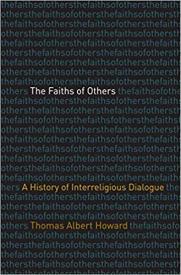The Faith of Others: A History of Interreligious Dialogue
 Several questions enliven Thomas Albert Howard’s fast-paced history of interreligious dialogue. Where did the interfaith movement come from? Where is it going? “Rarely in history is something entirely unprecedented,” he writes, so how does interfaith dialogue go from “virtually nonexistent, or rare and episodic at best, in the premodern and much of the modern era . . . to becoming a widely embraced ideal in the twentieth century”?
Several questions enliven Thomas Albert Howard’s fast-paced history of interreligious dialogue. Where did the interfaith movement come from? Where is it going? “Rarely in history is something entirely unprecedented,” he writes, so how does interfaith dialogue go from “virtually nonexistent, or rare and episodic at best, in the premodern and much of the modern era . . . to becoming a widely embraced ideal in the twentieth century”?
A professor of humanities and history who holds a chair in Christian ethics at Valparaiso University, Howard tells the story of today’s expanding interfaith engagement by focusing on four pivotal moments. He begins in the 16th-century Mughal Empire in India, where the Muslim emperor Akbar hosted intellectual salons with Jews and Christians. He ends in Rome with the promulgation of Nostra aetate by the Catholic Church in 1965. In between, Howard introduces a chapter on the first Parliament of the World’s Religions in Chicago in 1893 and another devoted to the less well-known 1924 London Conference on Some Living Religions within the Empire, which introduced Eastern religions and Islam to the British public.
Summary Excerpted From: Christian Century
Soloff, Emily, “The Historical Roots of Interfaith Dialogue.” Christian Century (27 December 2021) https://www.christiancentury.org/review/books/historical-roots-interfaith-dialogue.
Publisher’s Website: https://wwnorton.com/books/9780393329339/about-the-book/description
Recommended Citation (Chicago):
Howard, Thomas ALbert. The Faith of Others: A History of Interreligous Dialogue. Grand Rapids: Yale University Press, 2021.
